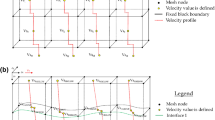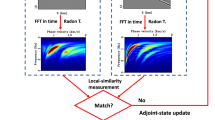Abstract
A series of kinematic inversions based on robust non-linear optimization approach were performed using travel time data from a series of seismic refraction experiments: CELEBRATION 2000, ALP 2002 and SUDETES 2003. These experiments were performed in Central Europe from 2000 to 2003. Data from 8 profiles (CEL09, CEL10, Alp01, S01, S02, S03, S04 and S05) were processed in this study. The goal of this work was to find seismic velocity models yielding travel times consistent with observed data.
Optimum 2D inhomogeneous isotropic P-wave velocity models were computed. We have developed and used a specialized two-step inverse procedure. In the first “parametric” step, the velocity model contains interfaces whose shapes are defined by a number of parameters. The velocity along each interface is supposed to be constant but may be different along the upper and lower side of the interface. Linear vertical interpolation is used for points in between interfaces. All parameters are searched for using robust non-linear optimization (Differential Evolution algorithm). Rays are continuously traced by the bending technique. In the second “tomographic” step, small-scale velocity perturbations are introduced in a dense grid covering the currently obtained velocity model. Rays are fixed in this step. Final velocity models yield travel time residuals comparable to typical picking errors (RMS ∼ 0.1 s).
As a result, depth-velocity cross-sections of P waves along all processed profiles are obtained. The depth range of the models is 35–50 km, the velocity varies in the range 3.5–8.2 km/s. Lowest velocities are detected in near-surface depth sections crossing sedimentary formations. The middle crust is generally more homogeneous and has typical P wave velocity around 6 km/s. Surprisingly the lower crust is less homogeneous and the computed velocity is in the range 6.5–7.5 km/s. The MOHO is detected in the depth ≈30–45 km.
Similar content being viewed by others
References
Běhounková M., Čížková H. and Matyska C., 2005. Resolution tests of global geodynamic models by travel-time tomography. Stud. Geophys. Geod., 49, 343–363.
Brückl E., Bodoky T., Hegedüs E., Hrubcová P., Gosar A., Grad M., Guterch A., Hajnal Z., Keller G.R., A. Špičák A., Sumanovac F., Thybo H., Weber F. and ALP 2002 Working Group, (2003). ALP 2002 seismic experiment. Stud. Geophys. Geod., 47, 671–679.
Efron B. and Tibshirani R., 1991. Statistical Data Analysis in the Computer Age. Science, 253, 390–395.
Grad M., Špičák A., Keller G.R., Brož M., Hegedüs E. and SUDETES 2003 Working Group, 2003. SUDETES 2003 seismic experiment. Stud. Geophys. Geod., 47, 681–689.
Guterch A., Grad M., Keller G.R., Posgay K., Vozár J., Špičák A., Brückl E., Hajnal Z., Thybo H., Selvi O. and CELEBRATION 2000 Working Group, 2003a. CELEBRATION 2000 seismic experiment. Stud. Geophys. Geod., 47, 659–669.
Guterch A., Grad M., Špičák A., Brückl E., Hegedüs E., Keller G.R., Thybo H. and CELEBRATION 2000, ALP 2002, SUDETES 2003 Working Groups, 2003b. An overview of recent seismic refraction experiments in Central Europe. Stud. Geophys. Geod., 47, 651–657.
Hole, J.A., 1992. Nonlinear high resolution three-dimensional seismic travel time tomography. J. Geophys. Res., 97(B5), 6553–6562.
Hrubcová P., Šroda P., Špičák A., A. Guterch, M. Grad, G. R. Keller, E. Brückl, and H. Thybo, 2005. Crustal and uppermost mantle structure of the Bohemian Massif based on CELEBRATION 2000 data. J. Geophys. Res., 110, B11305, doi:10.1029/2004JB003080.
Landes M., O’Reilly B.M., Readman P.W., Shannon P.M. and Prodehl C., 2003. VARNET-96: three-dimensional upper crustal velocity structure of SW Ireland. Geophys. J. Int., 153, 424–442.
Majdañski M, Grad M, Guterch A, and the SUDETES 2003 Working Group, 2006. 2-D seismic tomographic and ray tracing modelling of the crustal structure across the Sudetes Mountains basing on SUDETES 2003 experiment data. Tectonophysics, 413, 249–269.
Málek J., Brož M., Fischer T., Horálek J., Hrubcová P., Janský J., Novotný O., Růžek B. and the CELEBRATION Working Group, 2001. Seismic measurements along short profiles in Western Bohemia during the CELEBRATION 2000 experiment. Acta Montana IRSM AS CR, 18, 15–28.
Michelini A., Živčič M. and Suhadolc P., 1998. Simultaneous inversion for velocity structure and hypocenters in Slovenia. J. Seismol., 2, 257–265.
Press W.H., Teukolsky S.A., Vetterling W.T. and Flannery B.P., 1992. Numerical Recipes in C. The Art of Scientific Computing. Second Edition. Cambridge University Press.
Price K. and Storn R., 1997. Differential Evolution. Dr. Dobb’s Journal, April 1997, 18–24.
Puliam R.J., Vasco D.W. and Johnson L.R., 1993. Tomographic inversion for mantle P wave velocity structure based on the minimization of L2 and L1 norms of International Seismological Centre travel time residuals. J. Geophys. Res., 98(B1), 699–734.
Puliam R.J. and Start P.B., 1994. Confidence regions for mantle heterogeneity. J. Geophys. Res., 99, 6931–6943.
Růžek B. and Kvasnička M., 2001. Differential evolution algorithm in the earthquake hypocenter location. Pure Appl. Geophys., 158, 667–693.
Růžek B. and Kvasnička M., 2005. Earthquake hypocenter location: a challenge for the differential evolution algorithm. In: K. Price, R. Storn and J. Lampinen (Eds.), Differential Evolution, A Practical Approach to Global Optimization, Springer-Verlag Berlin, 379–392.
Růžek B., Vavryčuk V., Hrubcová P. and Zedník J. and the CELEBRATION 2000 working group, 2003. Crustal anisotropy in the Bohemian Massif, Czech Republic: observations based on Central European Lithospheric Experiment Based on Refraction (CELEBRATION) 2000. J. Geophys. Res., 108(B8), 2392, oi:10.1029/2002JB002242.
Scarpa R., 1993. Seismic tomography and modeling of complex geological structures. J. of Appl. Geophys., 30, 119–130.
Song L.P., Koch M., Koch K. and Schlittenhardt J., 2004. 2D-anisotropic Pn-velocity tomography underneath Germany using regional traveltimes. Geophys. J. Int., 157, 645–663.
Stark P.B., 1992. Inference in infinite-dimensional inverse problems: discretization and duality. J. Geophys. Res., 97(B10), 14055–14082.
Storn R. and Price K., 1997. Differential Evolution — A simple and efficient heuristic for global optimization over continuous spaces. J. Glob. Optim., 11, 241–354.
Tichelaar B.W. and Ruff L.J., 1989. How good are our best models? Jackknifing, bootstrapping, and earthquake depth. EOS Trans. AGU, 16, 593.
Um J. and Thurber C., 1987. A fast algorithm for two-point seismic ray tracing. Bull. Seismol. Soc. Amer., 77, 972–986.
Vavryčuk V., Hrubcová P., Brož M. and Málek J. and the ALP 2002 working group, 2004. Azimuthal variation of Pg velocity in the Moldanubian, Czech Republic: observation based on a multiazimuthal common-shot experiment. Tectonophysics, 387, 189–203.
Wessel P. and Smith W.H.F., 1991. Free software helps map and display data. EOS Trans. AGU, 441, 72.
Zelt C.A., 1998. Lateral velocity resolution from three-dimensional seismic refraction data. Geophys. J. Int., 135, 1101–1112.
Zelt C.A., Sain K., Naumenko J.V. and Sawyer D.S., 2003. Assessment of crustal velocity models using seismic refraction and reflection tomography. Geophys. J. Int., 153, 609–626.
Zhang H. and Thurber C., 2005. Adaptive mesh seismic tomography based on tetrahedral and Voronoi diagrams: Application to Parkfield, California. J. Geophys. Res., 110(B4), B04303, doi:10.1029/2004JB003186.
Author information
Authors and Affiliations
Rights and permissions
About this article
Cite this article
Růžek, B., Hrubcová, P., Novotný, M. et al. Inversion of travel times obtained during active seismic refraction experiments CELEBRATION 2000, ALP 2002 and SUDETES 2003. Stud Geophys Geod 51, 141–164 (2007). https://doi.org/10.1007/s11200-007-0007-6
Received:
Revised:
Accepted:
Issue Date:
DOI: https://doi.org/10.1007/s11200-007-0007-6




